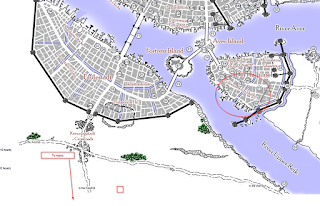There are countless cults in the Empire (or so they say) but not all of them are know to Wigmar and friends...
THE PURPLE HAND
This cult is by far the best known to Wigmar. It's the cult of Kastor Liberung, Wigmar's double, and in many ways responsible - despite the cult's best efforts it should be noted - for his current good fortunes.
The cult appears widespread, having a following in Middenheim (appears to be the main seat of the guild), Altdorf, and Nuln (at least two separate cells). It's not universal, however, lacking followers in smaller towns. For example, there didn't seem to be any Hand cultists in Bögenhafen. And the cell that came after Wigmar in Übersreik were not locals.
Senior members are known as 'Magisters' and Kastor carried the title 'magister impedimentae' while in Nuln. His responsibilities including procuring for the cult what it needed - including living humans (presumably for human sacrifice, although this has never been proven).
The cult uses magic (chaos sorcery) when necessary but seems to work primarily throguh more mundane means.
The cult's goals are not clear, but it seems concerned with material wealth (as exemplified by Kastor's false inheritance) and power (access to/control over the Elector-Countess of Nuln). Beyond that it's anybody's guess.
A certain "Captain Scharlach of Middenheim" was named by cultists sent by the Hand to murder Wigmar in Ubersreik. He's supposedly a Watch Captain of the City of the White Wolf.
THE RED CROWN
Etelka Hertzen is the best known cultist of the Red Crown. Her apprentice Ernst Heidelmann a distant second.
Unlike the Purple Hand, the Red Crown works with beastmen and greenskins (and who knows what other monstrosities).
Beyond Hertzen's fixation on Dagmar von Wittgenstein's great warpstone, nothing is known of the cult's goals or modus operandi.
Is the Red Crown in any way connected to the Purple Hand? Possibly. Heidelmann had spent time in Middenheim, the seat of the Hand. On the other hand, Middenheim is one of the places in the Empire with the highest concentrations of wizards and mystics, so it doesn't necessarily mean anything.
ORDO SEPTINARIUS
This is the cult that was wiped out (or rather, the inner council was dealt with) in Bögenhafen. An inner council of seven, with each senior member leading a cell of seven member s that were unaware of the identity of the others.
Franz Steinhäger certainly knew that he was consorting with daemonic forces and the other members of the inner council had to know they were messing with forces that shall not be named. Yet despite these facts there was a certain naiveté to the cult, as if it was just taking its first, stumbling steps down the path to damnation.
It's not entirely clear how the Order of Seven relates to other cults. It did not seem connected to Kastor Liberung - beyond the fact that both used sorcery and that the Order may have been unknowingly (?) aligned with the Great Corruptor. Likewise, while Johannes Teugen knew Etelka Hertzen from their time in Nuln, and Franz Steinhäger exchanged damning letters with the witch, it doesn't appear that they were part of the Red Crown.
THE JADE SCEPTRE
Mentioned only. Possibly active in Middenheim but no known members have been named. Unclear if it's another cult of the Changer or if its devoted to some other foul power.
THE VON WITTGENSTEIN FAMILY
Even if Wigmar lives to see 100 years of age he'll be hard pressed to finds a more thoroughly corrupt family. They are all dead now, thankfully, except Margritte's brother, Gotthard von Wittgenstein. He's known to be residing in Middenheim. And the letters he exchanged with his sister are enough to damn him many times over. But is he a sorcerer like his sister? And is he involved with this cult or that?
THE DRINKER'S GET
The get of Ahalt, the Drinker. Bloodthirsty savages that engage in ancient rituals and can take the shape of wolves. How do they relate to Chaos and other cults? How widespread are they? Why do they hate Taal and Rhya so much?












